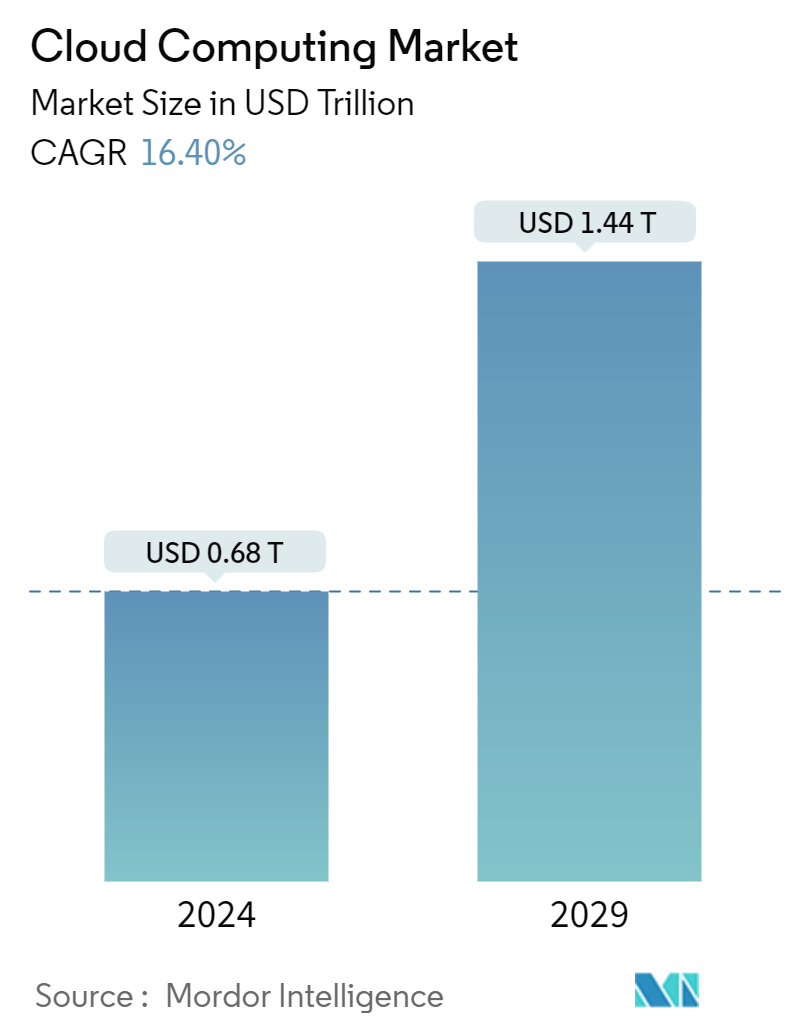Market Size of Cloud Computing Industry

| Study Period | 2019 - 2029 |
| Market Size (2024) | USD 0.68 Trillion |
| Market Size (2029) | USD 1.44 Trillion |
| CAGR (2024 - 2029) | 16.40 % |
| Fastest Growing Market | Asia-Pacific |
| Largest Market | North America |
Major Players
*Disclaimer: Major Players sorted in no particular order |
Cloud Computing Market Analysis
The Cloud Computing Market size is estimated at USD 0.68 trillion in 2024, and is expected to reach USD 1.44 trillion by 2029, growing at a CAGR of 16.40% during the forecast period (2024-2029).
Enterprise routers are crucial products used daily by businesses globally. The increasing global demand for cloud computing is driven by emerging technologies such as big data, artificial intelligence (AI), and machine learning (ML). The growing focus on customer-centric applications to enhance consumer satisfaction also contributes to these technologies' rise.
Cloud-based infrastructure provides flexible and on-demand resource access, supporting new digital business solutions. This technology is beneficial for enterprise resource planning (ERP), online transaction processing (OLTP), and supply chain management (SCM) across various sectors.
In May 2024, Amazon Web Services (AWS), Amazon's cloud computing division, announced a substantial investment of EUR 7.8 billion (USD 8.5 billion) in the AWS European Sovereign Cloud initiative. The first cloud region will be established in Germany and operational by the end of 2025. This investment will continue until 2040. The purpose of this Sovereign Cloud is to enhance data residency across Europe.
The market is also witnessing several investments that significantly drive the adoption of cloud computing. For instance, in April 2024, Oracle Corporation Japan unveiled an ambitious plan, committing over USD 8 billion in the coming decade. This investment is strategically aimed at catering to Japan's escalating cloud computing and AI infrastructure needs. The initiative will bolster the presence of Oracle Cloud Infrastructure (OCI) and underscore Oracle's commitment to the Japanese market.
Also, recognizing the importance of digital sovereignty, Oracle is set to ramp up its operations. This expansion substantially boosts its engineering teams, focusing on recruiting local talent and aligning closely with Japan's requirements.
Organizations increasingly require secure and efficient solutions to facilitate remote work for their employees, including contact center agents and creative professionals. Providers are addressing this need by offering specialized cloud-based solutions that ensure security, timeliness, and cost-effectiveness.
Cloud computing, a technology that provides on-demand platforms, software, and infrastructure, is vulnerable to various data breaches. Customers still express concerns about outsourcing their data to public cloud services when assured of strong security measures. Despite the efforts of cloud service providers to protect client data, several data breach incidents have affected even the most prominent businesses.
For instance, in June 2024, Thales unveiled its 2024 Cloud Security Study, a comprehensive annual report that examines the latest cloud security threats, trends, and emerging risks. The study gathers insights from a survey of nearly 3000 IT and security professionals across 18 countries and 37 industries.
As organizations increasingly depend on cloud services, these resources have become prime targets for cyber-attacks. Specifically, SaaS applications (31%), cloud storage (30%), and cloud management infrastructure (26%) are the most frequently attacked categories. Consequently, protecting cloud environments has become the foremost security priority, surpassing all other security disciplines.
The study also states that 44% of organizations have experienced a cloud data breach, with 14% reporting an incident in the last 12 months. Human error and misconfiguration remain the leading causes of these breaches (31%), followed by the exploitation of known vulnerabilities (28%) and the failure to use multi-factor authentication (17%).
Further, macroeconomic trends have a significant impact on the cloud computing market. The rising inflationary pressure will likely increase the costs of professional services for companies operating in a cloud environment. For instance, according to OECD, the annual monthly inflation rate in the Organization for Economic Co-Operation and Development (OECD) increased steadily from February 2021 to October 2022, when the inflation rate reached 10.7% compared to the same month the previous year.
Cloud Computing Industry Segmentation
Cloud computing is the supply of computing services over the internet, including servers, storage, databases, networking, software, analytics, and intelligence to provide quicker innovation, adaptable resources, and scale economies. Customers usually only pay for the cloud services they use, which helps to save operational costs, run infrastructure more effectively, and scale as business requirements change.
The cloud computing market is segmented by computing type (IaaS, Sa aS, and PaaS), end-user verticals (IT and telecom, BFSI, retail, consumer goods, manufacturing, healthcare, and media and entertainment), and geography (North America [United States and Canada], Europe [United Kingdom, Italy, France, Germany, Russia, and Rest of Europe], Asia-Pacific [China, India, Japan, South Korea, and Rest of Asia-Pacific], Latin America [Brazil, Mexico, Argentina, and Rest of Latin America], and the Middle East and Africa [Brazil, Mexico, Argentina, and the Rest of Middle East and Africa]). The market sizes and forecasts are provided in terms of value (USD) for all the above segments.
| By Computing Type | |
| IaaS | |
| SaaS | |
| PaaS |
| By End-user Verticals | |
| IT and Telecom | |
| BFSI | |
| Retail and Consumer Goods | |
| Manufacturing | |
| Healthcare | |
| Media and Entertainment |
| By Geography*** | ||||||||
| ||||||||
| ||||||||
| ||||||||
| Australia and New Zealand | ||||||||
| Latin America | ||||||||
| Middle East and Africa |
Cloud Computing Market Size Summary
The cloud computing market is poised for significant growth, driven by the increasing adoption of emerging technologies such as big data, artificial intelligence, and machine learning. These technologies are enhancing customer-centric applications, thereby boosting the demand for cloud-based infrastructure. This infrastructure offers flexible and on-demand resource access, supporting digital business solutions across various sectors, including enterprise resource planning, online transaction processing, and supply chain management. Major players like Amazon Web Services, Oracle, and Microsoft are making substantial investments to expand their cloud services and infrastructure, with a focus on enhancing data residency and catering to specific regional needs, such as in Europe and Japan. The market is characterized by strategic partnerships and collaborations aimed at accelerating cloud adoption and modernization of applications.
Despite the promising growth, the cloud computing market faces challenges, particularly concerning data security and breaches. As organizations increasingly rely on cloud services, these platforms have become prime targets for cyber-attacks, necessitating a strong focus on security measures. Human error, misconfiguration, and the exploitation of known vulnerabilities are leading causes of data breaches, highlighting the need for robust security protocols. The market's expansion is also influenced by macroeconomic trends, such as inflation, which can impact the costs of professional services in a cloud environment. Nonetheless, the shift from traditional on-premises server models to cloud computing offers significant opportunities for automation and efficiency, driving businesses to integrate cloud technologies into their operations and enhancing their digital transformation efforts.
Cloud Computing Market Size - Table of Contents
-
1. MARKET DYNAMICS
-
1.1 Market Overview
-
1.2 Market Drivers
-
1.2.1 Robust Shift Towards Digital Transformation Across the World
-
1.2.2 Post-Pandemic Remote Work-Related Policies Positively Impacting the Cloud Market
-
-
1.3 Market Challenges
-
1.3.1 Regulatory Compliance and Data Breaching Risk
-
-
1.4 Market Opportunities
-
1.5 Industry Ecosystem Analysis
-
1.6 Assessment of Macro Economic Trends on the Cloud Computing Landscape
-
1.7 Industry Attractiveness – Porter’s Five Forces Analysis
-
1.7.1 Threat of New Entrants
-
1.7.2 Bargaining Power of Buyers/Consumers
-
1.7.3 Bargaining Power of Suppliers
-
1.7.4 Threat of Substitute Products
-
1.7.5 Intensity of Competitive Rivalry
-
-
1.8 Industry Regulations and Standards
-
-
2. MARKET SEGMENTATION
-
2.1 By Computing Type
-
2.1.1 IaaS
-
2.1.2 SaaS
-
2.1.3 PaaS
-
-
2.2 By End-user Verticals
-
2.2.1 IT and Telecom
-
2.2.2 BFSI
-
2.2.3 Retail and Consumer Goods
-
2.2.4 Manufacturing
-
2.2.5 Healthcare
-
2.2.6 Media and Entertainment
-
-
2.3 By Geography***
-
2.3.1 North America
-
2.3.1.1 United States
-
2.3.1.2 Canada
-
-
2.3.2 Europe
-
2.3.2.1 United Kingdom
-
2.3.2.2 Germany
-
2.3.2.3 France
-
2.3.2.4 Spain
-
2.3.2.5 Nordics
-
2.3.2.6 Benelux
-
-
2.3.3 Asia
-
2.3.3.1 China
-
2.3.3.2 India
-
2.3.3.3 Japan
-
2.3.3.4 South Korea
-
-
2.3.4 Australia and New Zealand
-
2.3.5 Latin America
-
2.3.6 Middle East and Africa
-
-
Cloud Computing Market Size FAQs
How big is the Cloud Computing Market?
The Cloud Computing Market size is expected to reach USD 0.68 trillion in 2024 and grow at a CAGR of 16.40% to reach USD 1.44 trillion by 2029.
What is the current Cloud Computing Market size?
In 2024, the Cloud Computing Market size is expected to reach USD 0.68 trillion.

